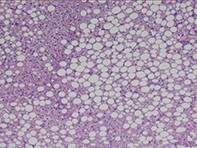Peer Reviewed
Gastroenterology clinic
Nonalcoholic fatty liver disease
Abstract
Non-alcoholic fatty liver disease affects about 15 to 20% of the population and is linked to obesity. Its prevalence in the community is increasing with the rising prevalence of people who are overweight or obese.
Key Points
- Nonalcoholic fatty liver disease (NAFLD) is the most common cause of abnormal liver enzymes in the Australian community. Current estimates are that 15 to 20% of the adult population have NAFLD.
- NAFLD is caused by the accumulation of triglyceride in hepatocytes. It coalesces into lipid droplets that displace cellular organelles to the periphery of the hepatocytes (Figure). This histological feature is called hepatic steatosis. The spectrum of NAFLD runs from bland steatosis to steatosis with hepatocyte injury, inflammation and fibrosis.
- The more severe form of NAFLD is known as nonalcoholic steatohepatitis (NASH). The prevalence of NASH is estimated to be 2 to 3% of the adult population. Patients with NASH are at risk of progressive liver disease, and about one-third of these patients will develop significant hepatic fibrosis or cirrhosis. Once patients have cirrhosis they can develop life-threatening complications such as liver failure and hepatocellular carcinoma.
Remember
Purchase the PDF version of this article
Already a subscriber? Login here.

